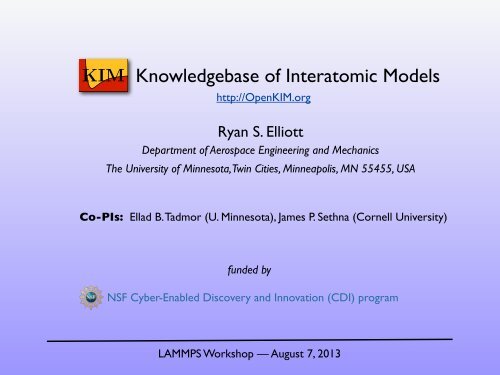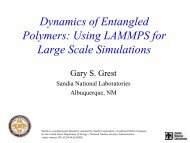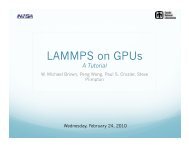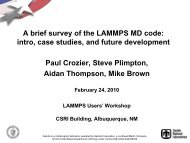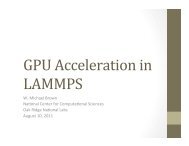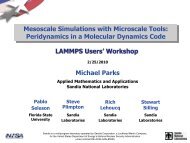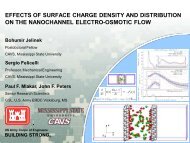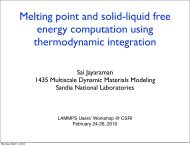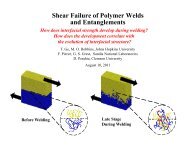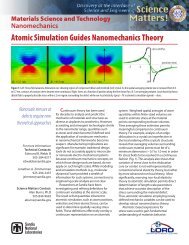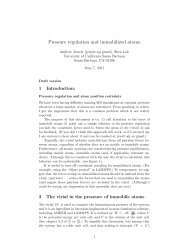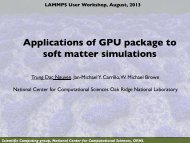The Knowledgebase of Interatomic Models (KIM) - Lammps
The Knowledgebase of Interatomic Models (KIM) - Lammps
The Knowledgebase of Interatomic Models (KIM) - Lammps
Create successful ePaper yourself
Turn your PDF publications into a flip-book with our unique Google optimized e-Paper software.
<strong>KIM</strong><br />
<strong>Knowledgebase</strong> <strong>of</strong> <strong>Interatomic</strong> <strong>Models</strong><br />
http://Open<strong>KIM</strong>.org<br />
Ryan S. Elliott<br />
Department <strong>of</strong> Aerospace Engineering and Mechanics<br />
<strong>The</strong> University <strong>of</strong> Minnesota, Twin Cities, Minneapolis, MN 55455, USA<br />
Co-PIs: Ellad B. Tadmor (U. Minnesota), James P. Sethna (Cornell University)<br />
funded by<br />
NSF Cyber-Enabled Discovery and Innovation (CDI) program<br />
LAMMPS Workshop — August 7, 2013
Four Barriers faced by Molecular Modelers<br />
Difficulties developers and users <strong>of</strong> interatomic models face include:<br />
1<br />
2<br />
No easy access to an extensive list <strong>of</strong> reliable reference data from<br />
experiments and first principles calculations for fitting.<br />
No easy access to implementations <strong>of</strong> existing models with known<br />
provenance and cross-language capability.<br />
3<br />
No standardized tests for evaluating properties <strong>of</strong> molecular systems.<br />
4<br />
No framework for evaluating the precision and transferability <strong>of</strong> models<br />
and therefore no rigorous guidelines for choosing an appropriate model<br />
for a given application.<br />
Open<strong>KIM</strong>.org<br />
2
Four Barriers faced by Molecular Modelers<br />
Difficulties developers and users <strong>of</strong> interatomic models face include:<br />
1<br />
2<br />
No easy access to an extensive list <strong>of</strong> reliable reference data from<br />
experiments and first principles calculations for fitting.<br />
No easy access to implementations <strong>of</strong> existing models with known<br />
provenance and cross-language capability.<br />
3<br />
No standardized tests for evaluating properties <strong>of</strong> molecular systems.<br />
4<br />
No framework for evaluating the precision and transferability <strong>of</strong> models<br />
and therefore no rigorous guidelines for choosing an appropriate model<br />
for a given application.<br />
Open<strong>KIM</strong>.org<br />
3
Four Barriers faced by Molecular Modelers<br />
Difficulties developers and users <strong>of</strong> interatomic models face include:<br />
1<br />
2<br />
No easy access to an extensive list <strong>of</strong> reliable reference data from<br />
experiments and first principles calculations for fitting.<br />
No easy access to implementations <strong>of</strong> existing models with known<br />
provenance and cross-language capability.<br />
3<br />
No standardized tests for evaluating properties <strong>of</strong> molecular systems.<br />
4<br />
No framework for evaluating the precision and transferability <strong>of</strong> models<br />
and therefore no rigorous guidelines for choosing an appropriate model<br />
for a given application.<br />
Open<strong>KIM</strong>.org<br />
4
Four Barriers faced by Molecular Modelers<br />
Difficulties developers and users <strong>of</strong> interatomic models face include:<br />
1<br />
2<br />
No easy access to an extensive list <strong>of</strong> reliable reference data from<br />
experiments and first principles calculations for fitting.<br />
No easy access to implementations <strong>of</strong> existing models with known<br />
provenance and cross-language capability.<br />
3<br />
No standardized tests for evaluating properties <strong>of</strong> molecular systems.<br />
4<br />
No framework for evaluating the precision and transferability <strong>of</strong> models<br />
and therefore no rigorous guidelines for choosing an appropriate model<br />
for a given application.<br />
Open<strong>KIM</strong>.org<br />
5
<strong>Knowledgebase</strong> <strong>of</strong> <strong>Interatomic</strong> <strong>Models</strong> (<strong>KIM</strong>)<br />
<strong>The</strong> <strong>Knowledgebase</strong> <strong>of</strong> <strong>Interatomic</strong> <strong>Models</strong> (<strong>KIM</strong>) project is<br />
based on a four-year NSF cyber-enabled discovery and<br />
innovation (CDI) grant and has the following main objectives:<br />
Stage I<br />
• Development <strong>of</strong> an online open resource for standardized testing long-term<br />
warehousing <strong>of</strong> interatomic models (potentials and force fields) and data.<br />
• Development <strong>of</strong> an application programming interface (API) standard for atomistic<br />
simulations, which will allow any interatomic model to work seamlessly with any<br />
atomistic simulation code.<br />
Stage II<br />
• Fostering the development <strong>of</strong> a quantitative theory <strong>of</strong> transferability <strong>of</strong> interatomic<br />
models to provide guidance for selecting application-appropriate models based on<br />
rigorous criteria, and error bounds on results.<br />
Open<strong>KIM</strong>.org<br />
6
<strong>KIM</strong> Overview<br />
Repository: A user-extendible database <strong>of</strong><br />
‣ interatomic <strong>Models</strong><br />
‣ standardized Tests (simulation codes)<br />
‣ Predictions (results from Model-Test couplings)<br />
‣ Reference Data (obtained from experiments<br />
and first principles calculations)<br />
Web portal: A web interface that will facilitate:<br />
‣ user upload and download <strong>of</strong> Tests, <strong>Models</strong> and<br />
Reference Data<br />
‣ searching and querying the repository<br />
‣ comparing and visualizing Predictions and Reference Data<br />
‣ recording user feedback<br />
Processing pipeline: An automatic system for generating Predictions by<br />
mating Tests and <strong>Models</strong> in the <strong>KIM</strong> Repository.<br />
‣ puts the “knowledge” in “knowledgebase”<br />
Open<strong>KIM</strong>.org<br />
7
<strong>KIM</strong> API Standard<br />
An Application Programming Interface (API) standard has been defined which enables<br />
any Test to work seamlessly with any Model.<br />
Test<br />
(simulation code)<br />
main program<br />
• Stand-alone computer program or<br />
input script to library code that<br />
computes a property <strong>of</strong> interest.<br />
• Can be written in any language<br />
supported by the API (Fortran 77,<br />
Fortran 90, C, C++, Python, Java, ...)<br />
pointer<br />
pointer<br />
standardized,<br />
packed<br />
data<br />
structure<br />
“API Object”<br />
Model<br />
(interatomic potential)<br />
subroutine<br />
• Subroutine that given a set <strong>of</strong><br />
atomic positions, species, ...<br />
computes energy, forces, ...<br />
• Can be written in any language<br />
supported by the API (Fortran 77,<br />
Fortran 90, C, C++, Python, Java, ...)<br />
Objective: to have the <strong>KIM</strong> API be adopted as a community standard so that<br />
any interatomic Model will be able to be run with any simulation code.<br />
Open<strong>KIM</strong>.org<br />
8
Web page demo <strong>of</strong> <strong>Models</strong>, Tests, and Drivers
Scenario I: Information query/retrieval<br />
Interacting with <strong>KIM</strong><br />
Web portal<br />
Verified implementation <strong>of</strong><br />
Stillinger-Weber potential<br />
conforming to <strong>KIM</strong> API<br />
Repository<br />
Processing<br />
pipeline<br />
<strong>KIM</strong><br />
Open<strong>KIM</strong>.org<br />
10
Scenario II: Uploading new Test<br />
Interacting with <strong>KIM</strong><br />
Web portal<br />
Open<strong>KIM</strong>.org<br />
Repository<br />
Processing<br />
pipeline<br />
<strong>KIM</strong><br />
Couple Test T with all<br />
valid <strong>Models</strong> and store<br />
resulting Predictions in<br />
Repository.<br />
Test T<br />
Model 1<br />
Model 2<br />
Model 3<br />
Model 4<br />
!<br />
11
Scenario III: Uploading new Model<br />
Interacting with <strong>KIM</strong><br />
Web portal<br />
Open<strong>KIM</strong>.org<br />
Repository<br />
Processing<br />
pipeline<br />
<strong>KIM</strong><br />
Couple Model M with<br />
all valid Tests and store<br />
resulting Predictions in<br />
Repository.<br />
Model M<br />
Test 1<br />
Test 2<br />
Test 3<br />
Test 4<br />
!<br />
12 21
Web page demo <strong>of</strong> Pipeline, Test Results, and Visualization
Interacting with <strong>KIM</strong><br />
Scenario IV: Finding an appropriate potential for a given application<br />
Input structure<br />
Web portal<br />
Repository<br />
Processing<br />
pipeline<br />
<strong>KIM</strong><br />
List <strong>of</strong> suitable <strong>Models</strong><br />
ranked based on<br />
transferability score<br />
Open<strong>KIM</strong>.org<br />
14
<strong>KIM</strong> Organization<br />
‣ <strong>KIM</strong> Inaugural Meeting held in<br />
San Diego, Feb 26-27, 2011<br />
• 63 participants from 7 countries<br />
• Many key model developers present<br />
• Major code developers present:<br />
- LAMMPS, iMD, GROMACS, SPaSM,<br />
DL_POLY<br />
• <strong>KIM</strong> Requirements Document defined<br />
and posted online (open<strong>KIM</strong>.org/requirements).<br />
• <strong>KIM</strong> organizational structure decided and voted on:<br />
- <strong>KIM</strong> Director: Ellad Tadmor (U. Minnesota)<br />
- <strong>KIM</strong> Editor: Ryan Elliott (U. Minnesota)<br />
- <strong>KIM</strong> Board: Mike Baskes (UCSD/LANL),<br />
Chandler Becker (NIST),<br />
Ronald Miller (Carleton U.)<br />
• 378 <strong>KIM</strong> Members (July 2013)<br />
Susan Sinnott (U. Florida)<br />
Sadasivan Shankar (Intel)<br />
Aidan Thompson (Sandia)<br />
Open<strong>KIM</strong>.org<br />
15
Starting the Snowball Rolling<br />
• Current release: <strong>KIM</strong> API Version 1.2.1 (July 2013)<br />
• <strong>The</strong> current focus <strong>of</strong> the <strong>KIM</strong> project is to modify as many existing<br />
interatomic potentials to conform to the <strong>KIM</strong> API.<br />
• To facilitate this we are holding a series <strong>of</strong><br />
<strong>KIM</strong> Content Carnivals (KCC)<br />
• Travel expenses, local housing and honorarium can be provided<br />
to participants.<br />
• Participation by invitation only.<br />
• Previous: Minneapolis (3/12), Aachen (8/12), Singapore (10/12)<br />
• UPCOMING EVENTS:<br />
- None scheduled at this time but keep checking the website.<br />
For more information:<br />
http://open<strong>KIM</strong>.org<br />
Open<strong>KIM</strong>.org<br />
16


